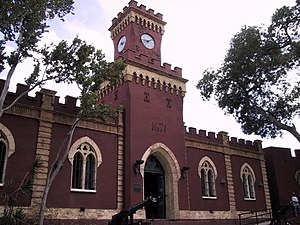Portal:Denmark
Welcome to the Denmark Portal! | ||||

|

|

| |
Denmark is the smallest and southernmost of the Nordic countries. Unified in the 10th century, it is also the oldest. Located north of its only land neighbour, Germany, south-west of Sweden, and south of Norway, it is located in northern Europe. From a cultural point of view, Denmark belongs to the family of Scandinavian countries although it is not located on the Scandinavian Peninsula. The national capital is Copenhagen.
Denmark borders both the Baltic and the North Sea. The country consists of a large peninsula, Jutland, which borders Schleswig-Holstein; many islands, most notably Zealand, Funen, Vendsyssel-Thy, Lolland, and Bornholm; and hundreds of minor islands often referred to as the Danish Archipelago. Denmark has historically controlled the approach to the Baltic Sea, and those waters are also known as the Danish straits.
Denmark has been a constitutional monarchy since 1849 and is a parliamentary democracy. It became a member of the European Economic Community (now the European Union) in 1973. The Kingdom of Denmark also encompasses two off-shore territories, Greenland and the Faroe Islands, both of which enjoy wide-ranging home rule. The Danish monarchy is the oldest existing monarchy in Europe, and the national flag is the oldest state flag in continuous use.
Selected biography
Piet Hein (December 16, 1905 - April 17, 1996) was a scientist, mathematician, inventor, author, and poet, often writing under the Old Norse pseudonym "Kumbel" meaning "tombstone". His short poems, gruks (or grooks), first started to appear in the daily newspaper Politiken shortly after the Nazi Occupation in April 1940 under the signature Kumbel Kumbell.
Piet Hein popularized the use of the superellipse in architecture, urban planning, and furniture making, and he invented the super-egg or superellipsoid based on the superellipse.
Recently selected: Thorvald Stauning - Nicolas Steno - Knud Rasmussen
Selected picture

Image credit: : Mali.
Selected article
Danish Muslim organizations, who objected to the depictions, responded by holding public protests attempting to raise awareness of Jyllands-Posten's publication. The controversy deepened when further examples of the cartoons were reprinted in newspapers in more than fifty other countries.
This led to protests across the Muslim world, some of which escalated into violence with police firing on the crowds (resulting in more than 100 deaths, altogether), including setting fire to the Danish Embassies in Syria, Lebanon and Iran, storming European buildings, and desecrating the Danish, Norwegian and German flags in Gaza City. While a number of Muslim leaders called for protesters to remain peaceful, other Muslim leaders across the globe, including Mahmoud al-Zahar of Hamas, issued death threats. Various groups, primarily in the Western world, responded by endorsing the Danish policies, including "Buy Danish" campaigns and other displays of support. Danish Prime Minister Anders Fogh Rasmussen described the controversy as Denmark's worst international crisis since World War II.
Selected place
Owing to its natural harbour and its strategic position in the Baltic Sea, Rønne has an interesting history coming under German and Swedish influence during its development as a herring fishing port. Today, with its quaint cobbled streets, half-timbered houses and interesting museums, it attracts visitors mainly from Denmark, Germany, Sweden and Poland.
Categories
Denmark topics
Things you can do
- Expand stubs:
Geography stubs · People stubs · Denmark stubs in general
Help us extend these stubs and make them real articles!
- Categorize:
Help us categorize Denmark-related articles
- WikiProjects:
Have a look at WikiProject Denmark, WikiProject Faroe Islands, WikiProject Greenland and WikiProject Norse history and culture
- Noticeboard:
Have a look at the Danish Wikipedians' notice board
- Geotag:
Find coordinates for these locations and tag them: articles missing geocoordinate data
Related portals
Northern Europe
Other countries
Associated WikiMedia
The following Wikimedia Foundation sister projects provide more on this subject:
-
Commons
Free media repository -
Wikibooks
Free textbooks and manuals -
Wikidata
Free knowledge base -
Wikinews
Free-content news -
Wikiquote
Collection of quotations -
Wikisource
Free-content library -
Wikispecies
Directory of species -
Wikiversity
Free learning tools -
Wikivoyage
Free travel guide -
Wiktionary
Dictionary and thesaurus













